Converting a Marlin 1895G from 18 1/2″ Round Barrel to 24″ Octagon Barrel
I started collecting Marlin lever action rifles a few months ago. A bit of nostalgia as the first NEW rifle I ever owned was a Marlin 336 in 30-30. My girlfriend at the time bought it for me as a birthday present. In 1972 it cost $79! (BTW…I married that girl!)
The bug hit when I saw a 1894 Cowboy at a gun shop. But the price was rather high. About ten times what that 336 cost many years ago. I looked around for a 1894CB in 45 Long Colt and soon found one just one town over. Seems the fellow bought it for Cowboy Action and lost interest. Next I found another 1894CB in 32H&R Magnum. This one came from half way across the country. The 32 H&R Magnum is one of my all time favorite cartridges. I have a number of revolvers chambered for it. A great plinking, small game round. I then started to look for a 22RF. I wanted a 1897 with its octagon barrel to match the other two, but a beautiful 39 Mountie made itself available from a friend so I snatched it up. This left me with a hole in the big bore category. The 45-70 has always been a favorite. One of these days I’ll get a Sabatti Double Rifle in this caliber. So the search started. Very hard to find an octagonal barrel in 45-70, but a buddy of mine was thinning out his collection and sold me his 1895G in just about new condition for a very good price. I bought it with the intention of shipping it off to one of the lever action gunsmiths to have a 22″ octagon barrel installed.

From This
To This
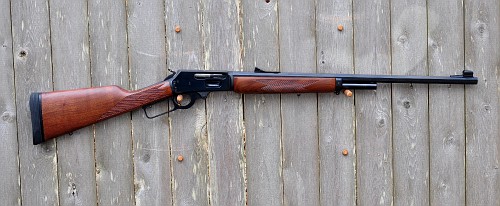
Looking for a proper gunsmith to effect the transformation on the various lever action forums, a fellow offered me a 45-70 CB octagon 26″ barrel in perfect shape for $50!!!! He went the opposite way, took a CB and had a short round barrel installed. So needless to say, I bought it. Now the fun begins.
First order of business was to remove the 18.5″ barrel. Easier said than done. I thought I’d have the barrel off in ten minutes. Understand, this isn’t my first Rodeo. I’ve been building rifles and modifying SSA revolvers and 1911 Pistols for years. I’ve had tough barrels to remove, but I’ve always succeeded. This one was a bugger! I tried everything. Made a new perfect fitting vise block. Use powdered sugar, rosen, even glued the barrel into the vise block with Super Glue. Just kept spinning. Even with 12 tons of force holding it! After an hour and a half I put the rifle back together and decided I’d have to send it off to a lever action specialist as I just couldn’t stop the barrel from turning in my vise blocks and I didn’t want to damage the barrel so parting near the shoulder was not an option. I went into the house, dejected, to have a cup of coffee.
After sitting in the house for a few minutes I got pissed! This rifle simply was not going to win. I tore it apart again and put it on the bench, sat on my stool and stared at it. A light bulb went off! This barrel has a flat bottom for the magazine tube and a dovetail for the rear sight. What if I put a piece of metal in the dove tail and a flat piece of aluminum plate on the barrels flat bottom and using my 12 ton barrel vice. Sounds like a plan!
Rather than use a piece of steel that might bend in the dovetail, I used a High Speed Steel lathe cutting bit, and a heavy piece of aluminum.
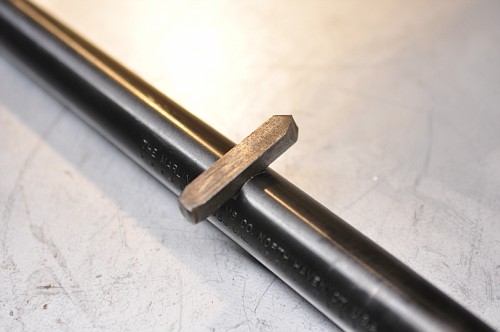
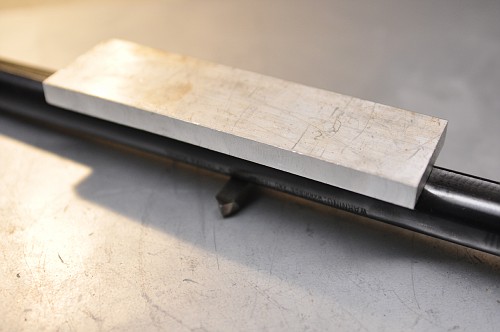
This was all sandwiched in my homemade 12 ton barrel vise.
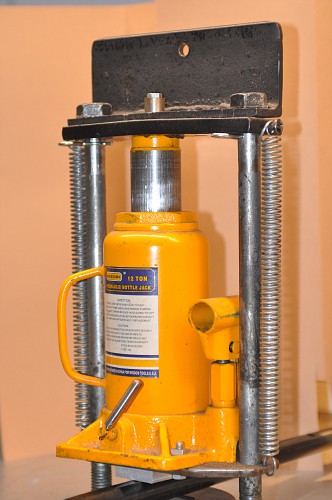
My Brownell’s action wrench was installed on the receiver with lots of duck tape to keep from scratching the blueing, and with a 3 pound dead-blow hammer………..Bang! It spun right off!
The replacement octagon barrel spun right on, stopped about an 1/8th of a turn from index, and with a bit of a heavy tug on the action wrench the extractor slot lined right up. This is a good thing, because if it went past index, it would not be an easy task to remove a bit of shoulder and then re-cut the intricacies of this chamber and barrel shank. As you can see, because it used square cut threads, quite a bit of shoulder would need to be removed to index another revolution. I think I lucked out Big Time!
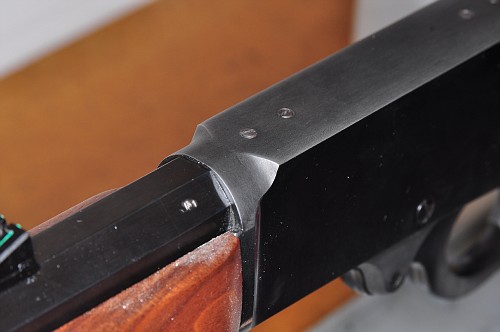
I put an empty 45-70 case in the chamber and the action locked up tight. I then put a piece of electrical tape on the head of the case and tried to close the bolt. Lots of resistance but if I really pulled on the lever, it would close. I added a piece of Scotch tape to the electrical tape and the action wouldn’t close. Excellent…….Hunter rifle lever headspace achieved. A couple empty cases with live primers confirmed that the rifle will go “bang”.
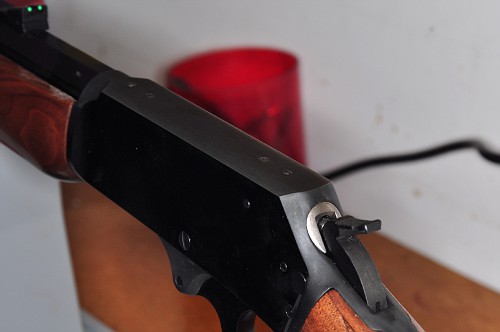
With this done there were lots of dovetails to cut and the barrel needed to be shortened. I needed to remove at lease an inch from the octagon barrel as I would not be using a full length magazine and therefore the bottom dovetail at the muzzle would need to be removed, and I was going to use a ramp front sight block, so the front sight dovetail was not needed. Originally I thought the rifle would look and handle great with a 22 inch barrel. But as I looked at it I decided to cut the barrel at 24 inches. I can always shorten it again later, but trying to weld that 2 inch piece back on if I decided I wanted it at 24 inches would be a real chore!
 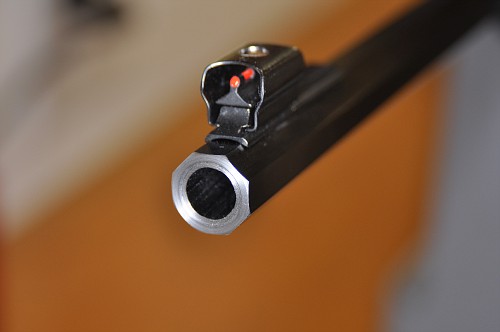
The barrel was chucked up in the lathe and cut to 24 inches. My lathe always wears a 6 jaw True Adjust. With this type of chuck I can indicate the bore of a barrel to perfect in a few seconds. But a 6 jaw will not work on an 8 sided barrel. So I removed the True Adjust and installed my 4-Jaw. Man, now I know why I got a True-Adjust. This four jaw took nearly 20 minutes to get the bore dialed in.
A nice, recessed target crown was cut and the outside edges of the muzzle chamfered to 45 degrees.

This done it was off to the milling machine as two new dovetails needed to be cut. One dovetail was for the forend band and the other was for the magazine tube. I use the milling machine to cut the main channel of the dovetail and to set the depth, but I like to file the angles by hand. Nothing makes me feel more like a genuine gunsmith than using a nice hand file on a firearm.
To mark the location of the dove tails I simply used the magazine tube and the forend band and scribed a mark where they needed to fall. After the majority of the material was milled out, it was file, trial fit, and file some more. I short order the two dovetails were done and everything fit perfectly!

Next was the front sight ramp. It’s been a long time since I’ve drilled and tapped blind holes in a firearm. Most of the work I’ve been doing for the past few years involved long range benchrest type rifles. Drilling and tapping is simply not needed with modern scoped actions. The new octagon barrel has a thickness of .125 and .138 where the front sight screws needed to locate. Therefore I could only drill to a depth of .085. I thought this was very shallow but upon measuring the factory barrel, it was the same depth. The milling machine was centered on the top rib and drilling commenced. DRO depth read out, don’t fail me now! The two screws are spaced exactly 1 inch apart. Moved the table an inch and bored and threaded the rear screw hole.
As it turned out, everything went perfectly! And the front sight ramp, although designed for a round barrel, fit perfectly. I had intended to mill the bottom flat, but this proved totally unnecessary. It flared just a bit over the top flat of the octagon barrel and looks awesome!
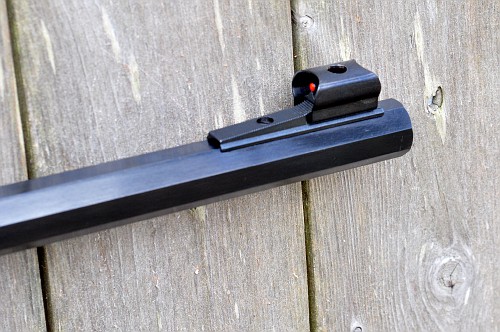
A set of Williams “Dove Tail Fire Sights” for a Marlin rifle were installed without and drama. I bored a hole into the top of the front sight cover to allow more light to strike the fiber optic.
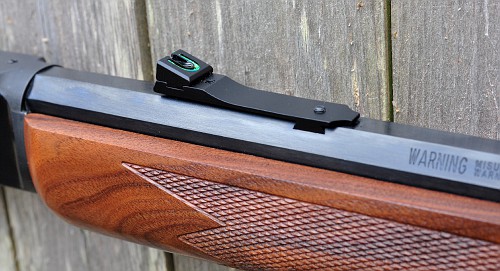
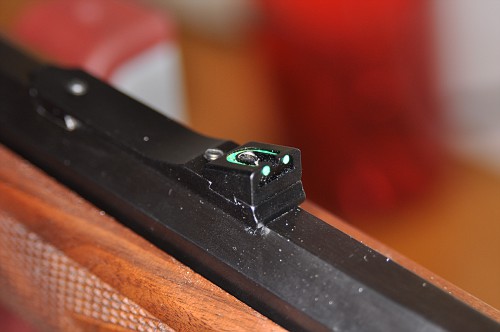
Although the extractor slot in the barrel and the receiver lined up perfectly, the barrel looked like it was off rotation by maybe a 1/10 of a degree. To check this I put a screw into the front and rear scope mount holes, and with a piece of fishing line attached to the rear screw, I rant the line up to the front sight. Both the front scope mount screw and the rear sight lined up perfectly. Must be an optical illusion.
The last thing I wanted to do was round off the top of the Marlin’s receiver. I never liked the look of the flat you with the angled sides, so with a nice bastard cut file, I rounded the top of the receiver to smooth everything out. I taped the sides and bead blasted the top and blued it with Brownell’s Gel Bluing. Nice!
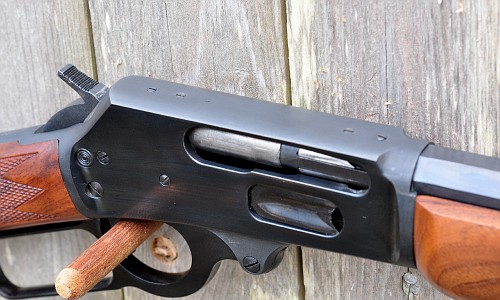
All the internal action parts were slicked up with a few Cratex stones in the trusty Dremel tool. Just remove ridges and tool marks. Don’t change any angles or bearing surfaces.
Put everything back together and the action is cool as the back side of your pillow!

So, with everything buttoned up it was off to the range to test fire. With a few loads using Varget and 7259 powder, windage was perfect. No adjustment necessary and elevation was 5″ low at 50 yards. A few clicks on the William’s sight to raise it and I shot a 1.5″ group. STANDING! The rifle handles perfectly.
Now I just need to find a Buffalo around here in Dartmouth Massachusetts!
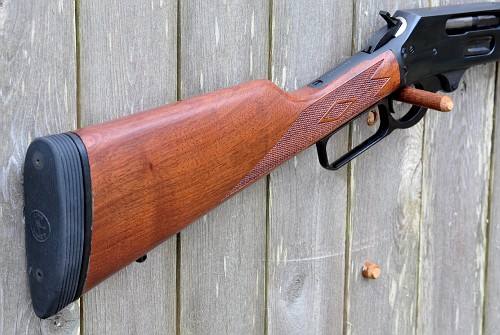
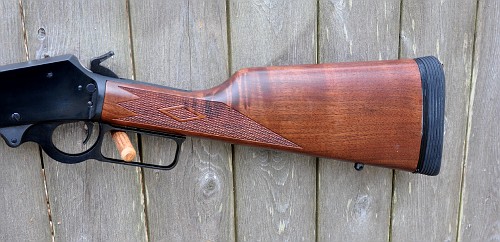
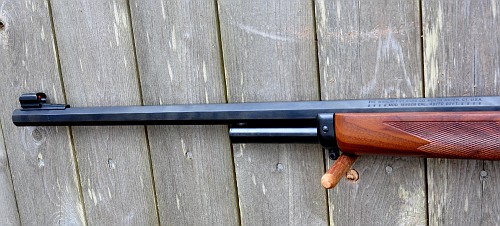
Lots more images here:
http://public.fotki.com/Rbertalotto/things-that-go-bang/marlin-1895g/
I hope you enjoyed this article. Donations to this web site are not necessary but always appreciated. You can use PayPal at rvb100@comcast.net. If you have any questions or comments you can leave them here or email me at this address. Thanks!

8 comments on “Marlin 1895G – From Round to Octagon Barrel”